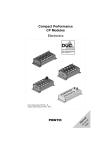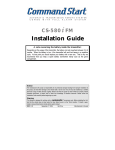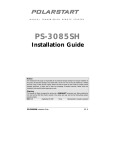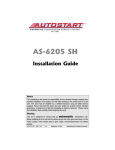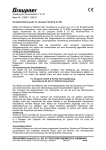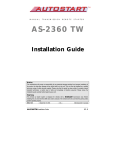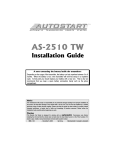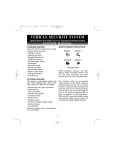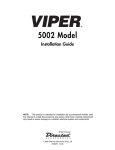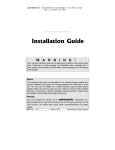Download Autostart AS-6070 TW Installation guide
Transcript
TWO -WAY MANUAL STARTER S Y S T E M TRANSMISSION W I T H F U L L REMOTE A L A R M AS-6070 TW-A Installation Guide A note concerning the battery inside the transmitter: Depending on your usage of the transmitter, the battery can last anywhere between 3 to 6 months. When the battery is low, the transmitter will produce two beeps in a repetitive cycle. At that point you should replace your battery with a new one. That is why we recommend that you keep a spare battery somewhere handy such as the glove compartment. Notice The manufacturer will accept no responsibility for any electrical damage resulting from improper installation of the product, be that either damage to the vehicle itself or to the Unit. This Unit must be installed by a certified technician using all safety devices supplied. Please note that this guide has been written for properly trained Autostart technicians: a certain level of skills and knowledge is therefore assumed. Please review the Installation Guide carefully before beginning any work. Warning This unit is designed for vehicles with a manual Transmission only. Before installing the Unit, test that the OEM Door Switch contacts of the vehicle work well, and that the Parking Brake system operates properly. Do not install on convertible vehicles. DOC.:1.00 November 11, 2004 CA Lp Manufactured in Canada Table of Contents Table of Contents .......................................2 Introduction.................................................2 Included in the Kit.......................................2 Installation Points to Remember ................3 Harness Description ...................................4 Flashing the Hood Pin Switch ....................8 Remember:.................................................9 The Programming Assistance Button ........9 Caution .......................................................9 Programming a Transmitter .......................9 Before Proceeding .....................................9 A Word of Caution about the Alarm...........9 Transmitter Programming Procedure ......10 Entering Programming Options Mode .....10 Programming Options ..............................11 Tach Programming...................................12 About Tach Programming ........................12 Multi-speed Tach Programming...............13 Automatic Tach Programming .................13 Testing......................................................13 Closing Up................................................15 Supplementary Information ......................15 Fifth Relay Output (2nd IGN, ACC or CRANK)....................................................15 Clutch bypass...........................................15 Ignition-controlled Door Locks .................17 Ignition Re-lock ........................................ 17 Secure Lock............................................. 18 Standard Secure Lock ............................. 18 Smart Secure Lock .................................. 18 Lock Pulse Duration................................. 18 Engine Run Time ..................................... 18 Siren or Horn Chirps ................................ 18 Open Zone Notification ............................ 19 Starter Kill (Installation)............................ 19 Passive or Active Arming......................... 19 Disarmed Notification............................... 19 Siren Mute ................................................ 19 Horn / Siren Mode.................................... 19 Shock Sense and Warn-away Sense ...... 19 Siren or Horn Chirp Timing ...................... 19 Resetting the System............................... 20 Events Logging ........................................ 21 Events playback....................................... 21 Start Failure Codes through the Parking Lights ........................................................ 21 Intrusion Codes........................................ 21 Intrusion Codes through the LED Light... 21 Diagnostics – Chirps Table...................... 21 Diagnostics – Parking Light Flash Table . 22 Introduction This guide contains all the information relevant and necessary for the installation of the alarm and remote starter system. Most of the features of this product are explained in the user guide. Therefore, if you need detailed information about a feature of the product, we recommend that you refer to the user guide. Included in the Kit Please carefully read the installation guide before beginning the installation, especially the harness description section and the programming options. It is very important that you familiarize yourself with the programming and the operation of the system, even if you have already installed a similar system in the past. There are many innovative features that you may overlook if you do not read this guide. Prior to the installation, make sure that all the hardware components required to install the system are in the box. P. 2 Installation Guide The following is a list of components included in the kit: • 1 – Remote Starter and Alarm System • 1 – five-pin 18 AWG Harness (Main Control Unit Harness) • 1 – Antenna Interconnect Cable • 1 – twelve-pin 22 AWG Harness (Accessories Harness) • 1 – multi-channel 5-button Remote Control • 1 – two-pin 22 AWG Harness (Accessories Harness) • 1 – plug-in dual-zone Shock Sensor • 1 – parts bag: a Hood Pin-switch, a • 1 – plug-in L.E.D. Connector and a Warning Label • 1 – high-power 120-dB 6-tone Siren • 1 – User Guide • 1 – six-pin 14 AWG Harness (Ignition Harness) • 1 – plug-in Valet Button INDUSTRY CANADA USER NOTICE: Operation is subject to the following two conditions: (1) this device may not cause interference, and (2) this device must accept any interference, including interference that may cause undesired operation of the device. To reduce potential radio interference to other users, the antenna type and its gain should be so chosen that the equivalent isotropically radiated power (EIRP) is not more than that required for successful communication. FCC USER NOTICE: The manufacturer is not responsible for any radio or TV interference caused by unauthorised modifications to this equipment. Such modifications could void the user’s authority to operate the equipment. Installation Points to Remember • When installing a manual-transmission product on a vehicle with a manual Transmission, always make sure that all Doors will get the Unit out of Ready Mode. Switch the wire used so that it is triggered by all Doors. • When installing a manual-transmission product on a vehicle with a manual Transmission, make sure that the Parking Brake and Door Switch contacts work properly. • When working on a vehicle, always leave a window open. • Never leave the keys in the car. Leave them on a workbench with a window rolled down. • If possible, remove courtesy light fuse to prevent battery drain. • The PROGRAMMING ASSISTANCE BUTTON (PAB) • The PAB is mounted on the side of the System unit and fulfils the same function as the Hood-Pin Switch. The PAB will spare installers the effort of getting out of the vehicle to access the Hood-Pin Switch. The PAB works only when the Hood is up. • Inspect vehicle for any body damage or electrical problems Installation Guide • Always solder and tape all connections. • Keep the Antenna away from other types of antennas (GPS/OnStar). • Never install the control unit where it could interfere with normal operation or obstruct service technicians. • Always use a grommet when running wires into the Engine compartment. Never run wires through bare or sharp metal. • Do not disconnect the battery on vehicles equipped with air bags and anti -theft radios. • Never ground the control unit to the vehicle’s steering column. • Make sure that all the switches and controls operate properly. • Verify that the vehicle starts and idles properly. • Make sure that all safety equipment is installed: the Valet Button (if provided), the Hood Switch and the Warning Label. • When wiring in parallel, make sure you isolate each connection with a diode in order to avoid feedback and possible damage. Examples: P. 3 • Wiring a Clutch Bypass and a Transponder Module to the GROUND OUT WHEN RUNNING wire: At the junction point, where the GROUND OUT WHEN RUNNING wire “splits” and connects to each device, a diode is inserted on each of these lines. • Multiple or separate Door pin Connec tions: • When joining all Door Pins together to the Door Pin input wire of the System unit, each wire must be isolated with a diode to prevent feedback. • Note: The above examples reflect common situations where diodes are use to isolate connections. Please note that there are numerous other cases where diode isolation is required. • Always make sure that all external relays or modules added to the System unit are properly fused and diode isolated. • Never test the Shock Sensor on glass with an open hand. Never hit glass hard enough as to break it. When testing on metal or plastic, make sure that the test will not damage the vehicle (e.g.: dents, broken glass, damaged trims, etc.). • On vehicles equipped with daytime running lights, the installer may be unable to see certain programming results since the daytime running lights never go out. • Note: The Parking Light Output Relay of the unit gives two clicking sounds for each flash of the lights: one click when the lights would go ON and one click when the lights would go OFF.) • Parking Light flashes to which the text refers throughout this manual refer to the Parking Light output of the unit, not of the vehicle. Harness Description When connecting a System, it is important to make sure that the connector with the Ground wire is connected first, before making the 12-volt connections. Should the Unit be powered up before being grounded, there could be serious damage to internal components of the Unit. Be careful not to power up a System before it is properly grounded. To avoid any accident, it is recommended to pull out the Fuses from their sockets before the installation, and to put them back during the very last steps. 6-Pin Main Ignition Harness Wire Colour Function Description Connect to the largest 12 V supply wire at the Ignition Harness. Ensure that the OEM power wire is fused for more than 30 A. Connect to the Starter wire of the vehicle. The source wire should have +12 V with the Ignition Key in the CRANK position only. Connect to the largest 12 V supply wire at the Ignition Harness. Ensure that the OEM power wire is fused for more than 30 A. Connect to the Ignition wire of the vehicle. The source wire should have +12 V with the Ignition Key in the IGNITION ON (RUN) and CRANK positions. Connect to the Accessories wire of the vehicle. The source wire must have power with the Ignition Key in the IGNITION ON (RUN) position only n ( o power in the CRANK position). This wire will power the Heater Fan. This high-current output can be used to power a second Ignition, Accessories or Crank wire. See Jumper Setting, later in this Guide, for correct output. A RED (+) 12 V Battery B PURPLE (+) Starter output (30 A) C RED (+) 12 V Battery D YELLOW (+) Ignition output (30 A) E ORANGE (+) Accessorie s output (30 A) F GREEN (+) Fifth Relay output (30 A) P. 4 Installation Guide 5-pin Secondary Harness Wire Colour Function 1 BLACK (–) Chassis ground input 2 PURPLE (A.C.) Tachometer input 3 GREY (–) Hood Switch input 4 ORANGE (+) Brake Switch input 5 YELLOW (+) 12 V Parking Light output Description This wire must be connected to bare, unpainted metal (the Chassis or the true Body ground). It is preferable to use a factory ground bolt rather than a self- tapping screw. Screws tend to get loose or rusted over time and can cause erratic problems. This wire must be connected to the negative side of the Ignition Coil in vehicles that use conventional coil systems. In Multi-coil systems, the Tach wire may be difficult to locate: the negative terminal of an injector may be used. Note: a Tach-programming procedure must be carried out after the installation is completed. Connect this wire to the installed Hood Pin switch supplied. This input will disable or shut down the Remote Starter when the Hood is up, and can also set off the Alarm. This wire must be connected to the Brake Light wire of the vehicle. This wire must have +12 V only when the Brake Pedal is down. This input will shut down the Remote Starter if the Brake Pedal is pressed. This wire provides a +12 V output and must be connected on the vehicle to the Parking Lights wire that tests +12 V when the Light switch is in the ON position. Note: ensure that the voltage does not decrease or increase when the dimmer control switch is turned. If the voltage goes up or down, find another Parking Light wire. 12-Pin Accessories Harness Wire Colour Function 1 BLUE (–) Trunk / AUX 3 output 2 BROWN (–) Lock output 3 GREEN (–) Unlock output 4 WHITE / BROWN (–) Rearm output 5 WHITE / GREEN (–) Disarm output Installation Guide Description 500 mA negative output. This output can be used to control the Trunk release (1-sec. pulse), or it can be set to operate as a constant output as long as the TRUNK button is held pressed (for Sunroof or Window closure) Programmable 500 mA negative output: 1/10-sec., 7/10sec. or 4-sec. pulse Programmable 500 mA negative output: 1/10-sec., 7/10sec., 4-sec. or double 1/4-sec. pulse (ON 250 ms, OFF 500 ms, ON 250 ms). 500 mA ground signal when the Doors are locked by remote control. This wire will go to ground 1/2 sec. before the LOCK pulse, and go out 1/8 sec after LOCK. The wire must be connected to the OEM Arm wire (usually the Door Pin). Note: The System will also give a Rearm pulse on this wire when it shuts down the vehicle after a remote start. 500 mA ground pulse when the Doors are unlocked by remote control. Connect to the OEM Disarm wire of the vehicle. Note: The system will also give a Disarm pulse on this wire P. 5 6 BLUE / WHITE 7 WHITE / ORANGE 8 ORANGE 9 PURPLE 10 WHITE 11 GREY P. 6 before every remote start. This input should be used in vehicles with positiveswitching Door pins or Dome Light circuits. Connect to the Dome Light wire that tests +12 V when a Door is open. Caution! The installer should use either the positive or the (+) Positive negative Door input. Never use both of them Door input simultaneously. It is essential that the System be connected in such a way as will allow each one of the Doors to turn off Ready Mode: the driver-side Door Pin does not constitute by itself a sufficient connection. This wire will provide a constant 500 mA output when the system is armed (locked by remote control). It can be connected to an external Starter Interrupt Relay. This wire should be connected to a Single Pole Double(–) Starter Kill Throw Relay: this wire will connect to Pin 85 on the Relay, output and Pin 86 will be connected to the Ignition wire. (armed The Starter Kill output becomes active during remote starts. output) One benefit of the Starter Kill is the Anti-Grind feature. Once the vehicle has been remote started, the Anti-Grind prevents the Starter Motor from re-engaging when the Ignition Key is inserted in the Ignition Switch and accidentally turned to the CRANK position. Connect to the negative Parking Brake Indicator Light wire (–) Parking of the vehicle. This wire is found at the parking brake lever Brake input itself. Note: The wire should test ground when the Parking Brake is engaged. (+) Siren or +12 V Siren output. Connect to the positive side of the Horn output Siren. This wire provides a constant 500 mA ground output while the System is running. This output becomes active at the same time as the Ignition and shuts off when the System (–) Ground shuts down, e.g.: when the Run Time has expired, when Out the START/STOP button has been pressed, etc. This output When can be used to activate external relays, bypass kits, etc.. Running Caution! If multiple relays or modules are connected to the GROUND OUT WHEN RUNNING wire, make sure they are diode isolated from one another: feedback may otherwise occur, causing damage to the vehicle. This input should be used in vehicles with negativeswitching Door pins or Dome Light circuits. Connect to the Dome Light wire that tests ground when a Door is open. Caution! The installer should use either the positive or the (–) Negative negative Door input. Never use both of them Door input simultaneously. It is essential that the System be connected in such a way as will allow each one of the Doors to turn off Ready Mode: the driver-side Door Pin does not constitute by itself a sufficient connection. Installation Guide In diesel mode, this positive input will monitor the glow plug light: it will wait for up to 18 seconds until the glow-plug light goes out before allowing the system to proceed to cranking the engine. Connect to the side of the glow-plug light which is positive when the light is on. Note: the system will nevertheless proceed to cranking the engine if the glow-plug light is still on after the 18sec. delay (25 sec. when the run time is set to 30 min.). A Note About The Diesel Glow-Plug Indicator Light: (Also known as the “wait-to-start light”.) The purpose of the glow-plug circuit on diesel vehicles is to pre-heat the combustion chamber before the vehicle is started. When a remote starter is installed on a diesel vehicle, the glow-plug section of the ignition circuit must be activated and allowed to operate before the vehicle is remote-started. For that purpose, the glow-plug input wire of the system must be connected to the glow-plug indicator light of the vehicle. 12 YELLOW Installation Guide (+) GlowPlug input Caution! The system will only accept positive glowplug input signals; therefore negative glow plugs should only be connected using relays to invert the polarity. A diode must be added between the negative glowplug trigger on the relay and the negative glow-plug wire of the car. This is to prevent feedback effects on the glow-plug indicator light on the instrument cluster: the light on the dash would come on because of the feedback, even though the circuit is off. When the user remote-starts the vehicle: • The system will power up the ignition circuit and wait to engage the starter motor while the glowplug indicator light is still on. • The system will engage the starter motor as soon as the glow-plug light (+) goes out. Minimum waiting time is 3 seconds. Maximum waiting time is 18 seconds. If no glow-plug wire is found on the vehicle, the glowplug input on the system may be “timed out”. The system will power up the ignition and glow-plug circuits and simply wait for the time-out before starting: • Connecting the glow-plug input wire of the system to ignition will hold the ignition on for the maximum waiting time (18 sec., recommended). • Keeping the glow-plug input wire of the system unconnected will hold the ignition on for the minimum waiting time (3 sec., not recommended in very cold environments). P. 7 Connect the glow-plug wire to the ignition wire only after the tach programming has been completed: connecting the glow-plug wire is one of the very last steps in the installation process. 2-Pin Harness Wire Colour 1 BLUE/ WHITE 2 YELLOW Function Description (–) AUX 2 output This 500 mA negative output can be programmed for one of the following Options: 1. Constant while the LOCK and UNLOCK buttons are pressed simultaneously, + 1 sec. after the buttons are released. 2. Pressing LOCK and UNLOCK simultaneously toggles the output on and off with automatic toggle off after 30 seconds. (–) Parking 500 mA negative Parking Light output. Light output Flashing the Hood Pin Switch Flashing the hood pin switc h is a procedure that brings the system into programming mode. Once the system is in programming mode, the installer will have up to 20 seconds to select one of the sub-menus. If the installer fails to select a sub-menu before the 20-second delay, the system will exit programming mode and the installer will have to flash the hood pin switch once more. Tip As long as the hood is up, you may use the programming assistance button instead of the hood pin switch. Here are the steps which the installer must follow in order to flash the Hood Pin switch: The Installer … The Module … 1. Press and hold the hood pin switch for 4 seconds. 2. Release the hood pin switch. The Parking Lights will turn ON. 3. While the parking lights are ON, press down the hood pin switch once more. 4. Release the hood pin switch again. Caution! If you press down and release the hood The Parking Lights will stay pin switch too many times, you will enter diagnostic for 20 seconds mode rather than programming mode. ON 5. You now have 20 seconds to select one of the submenus. Table 1: Flashing the Hood Pin switch Once the system has entered programming mode, you will have a selection of many different submenus, which will be described later in this guide: a. Transmitter Programming b. Programming Options c. Honk/Horn Timing (if available) d. Tach Programming P. 8 Installation Guide Remember: Once the Parking Lights are O N (solid), you have up to 20 seconds to select a submenu. If you do not select a sub-menu within 20 seconds, the System will exit Programming Mode and you will have to flash the Hood Pin switch once again. The Programming Assistance Button (A.k.a. the PAB.) Mounted on the system, this button can be used from within the vehicle instead of the hood pin switch in the engine compartment. This will spare the installer the trouble of accessing the hood pin switch in the engine compartment. Caution The hood pin switch must be installed and connec ted in order for the programming assistance button to function. The button will work only when the hood is up. Programming a Transmitter Before Proceeding The transmitter of the system is not delivered pre-programmed: it must be programmed after the wiring of the system is completed. The system has the ability to retain up to 4 different transmitter codes; if a fifth transmitter is programmed, the code of the first transmitter will be lost from memory. To erase all transmitter codes from memory, you must perform a reset of the system (see Resetting the System, later in this guide, for more details). A Word of Caution about the Alarm The alarm is triggered when the unit is powered up because the default state of the alarm is armed. You will therefore need to shut off the alarm before you carry out the transmitter code programming procedure. One way to shut off the alarm is to (1) set the system to valet mode and then (2) immediately set the system out of valet mode. (See instructions below.) Getting into valet mode 1. Turn the ignition key to the IGNITION ON (RUN) position. 2. Within 3 seconds, press and release the valet button (the parking lights will flash 3X and the L.E.D. will come on and stay lit). The system must exit valet mode before a transmitter programming procedure can be carried out: Getting out of valet mode 1. Turn the Ignition Key to the IGNITION ON (RUN) position. 2. Within 3 seconds, press and release the Valet Button (the parking lights will flash 2X and the L.E.D. will go out) (See section valet operation, in the user guide, for more details on the use of valet mode.) As the system exits valet mode, you will have 30 seconds to carry out the transmitter programming procedure before the alarm rearms. Installation Guide P. 9 Transmitter Programming Procedure 1. Flash the Hood Pin switch (see Table 1) – The Parking Lights will stay ON for up to 20 seconds. – Before the lights go out, turn the Ignition Key to the IGNITION ON (RUN) position. – Immediately turn the Ignition Key back to the OFF position. Press and hold the LOCK button and keep it down until the Parking Lights flash 5 times quickly. The siren will also chirp twice. – The System has stored the code of the Transmitter into memory. 2. To exit: close the Hood. Table 2: Programming a Transmitter Entering Programming Options Mode The system is equipped with three custom programming modes that allow the installer to custom-fit the system outputs according to installation requirements. The programming options are designed to facilitate interfacing with all vehicle types. (See section table of programming options later in this guide.) 1. Flash the Hood Pin switch (see Table 1) – The Parking Lights will stay ON for up to 20 seconds. – Before the lights go out: 2. Press and hold the Brake Pedal, – And press one of the following buttons on the Transmitter: • LOCK ................to access Mode 1; • UNLOCK.............to access Mode 2; • TRUNK...............to access Mode 3. The Parking Lights will flash and the Siren will chirp once, twice or three times to confirm entry into a Mode. 3. Release the Brake Pedal. Table 3: Accessing modes Note The unit will stay in the selected programming mode until the hood pin-switch or the brake pedal is pressed again. Therefore take your time to make the proper selection. Pressing the brake pedal will take you back to the programming centre, where you can select a different mode. Once you access a particular programming mode, you will automatically start at function 1. Once you select one of the options of function 1, you will automatically be taken to the next function. To select one of the four options of any given function, press the corresponding button on the transmitter: • LOCK button ...................... to access Option 1 • UNLOCK button .................. to access Option 2 • TRUNK button .................... to access Option 3 • START/STOP button ............. to access Option 4 Table 4: Accessing options In each function, once an option has been selected the parking lights will flash 1, 2, 3 or 4 times (depending on the selected option). Please note that the different functions within any particular mode can only be accessed sequentially: the programming centre will move from function 1 to function 2, then to function 3, P. 10 Installation Guide and so on. Therefore, whenever you access a particular mode, be prepared to re-configure all the functions of that mode in ascending order. Programming Options MODE 1 * INDICATES DEFAULT SETTING FUNCTION 1 – Ignition-controlled Door Locks OPTION 1* OPTION 2 OPTION 3 OPTION 4 Ignition Lock DISABLED Ignition Lock ENABLED Ignition UNLOCK ONLY Ignition LOCK ONLY FUNCTION 2 – Secure Lock OPTION 1* OPTION 2 OPTION 3 OPTION 4 Secure Lock DISABLED (1-sec. Disarm pulse) Secure Lock ENABLED in Smart Mode Secure Lock DISABLED (1/2-sec. Disarm pulse) Secure Lock ENABLED in Standard Mode FUNCTION 3 – Door lock pulse timing OPTION 1* OPTION 2 OPTION 3 OPTION 4 7/10-sec. Lock/Unlock pulses 4-sec. Lock/Unlock pulses 7/10-sec. Lock pulse and two 1/4-sec. Unlock pulses 1/10-sec. Lock/Unlock pulses FUNCTION 4 – AUX 3 Programming OPTION 1* OPTION 2 OPTION 3 OPTION 4 Constant output while the TRUNK button is pressed 1-sec. output when TRUNK button is pressed for 3 sec. with Ignition OFF or under remote run Output with Disarm and Rearm pulses (the Alarm is disarmed while the Trunk is open; the Alarm rearms automatically afterward) 1-sec. output when TRUNK button is pressed for 3 sec. with Ignition OFF or under remote run FUNCTION 5 – AUX 2 Programming OPTION 1* OPTION 2 OPTION 3 OPTION 4 MODE 2 Priority Door Access on 1st UNLOCK with unlocking of all doors on each subsequent UNLOCK; with CAR FINDER Toggle ON/OFF (with 30-second timeout) Constant output while the LOCK and UNLOCK buttons are pressed Priority Door Access on 1st UNLOCK and on each subsequent odd UNLOCK with unlocking of all doors on each subsequent even UNLOCK; with CAR FINDER * INDICATES DEFAULT SETTING FUNCTION 1 – Home Valet TM OPTION 1 OPTION 2* OPTION 3 Home Valet ENABLED Home Valet DISABLED Home Valet DISABLED FUNCTION 2 – Safe Start. OPTION 1 OPTION 2* OPTION 3 Safe Start ENABLED Safe Start DISABLED “Swap Start” – enhanced Safe Start Mode with extended safety: To start the Engine: press the LOCK and UNLOCK buttons simultaneously To trigger AUX 2: press the START/STOP button FUNCTION 3 – Engine Run Time OPTION 1 OPTION 2* OPTION 3 Installation Guide Run Time = 4 minutes in GAS mode / 9 minutes DIESEL mode Run Time = 15 minutes in GAS mode / 20 minutes DIESEL mode Run Time = 25 minutes in GAS mode / 30 minutes DIESEL mode P. 11 FUNCTION 4 – Turbo Mode OPTION 1 OPTION 2* OPTION 3 Turbo Mode ENABLED Turbo Mode DISABLED Turbo Mode DISABLED FUNCTION 5 – Engine type and Cold Weather Mode OPTION 1 OPTION 2* OPTION 3 Diesel Mode with 20-minute Run Time in Cold Weather Mode Gas Mode with 4-minute Run Time in Cold Weather Mode Diesel Mode with 9-minute Run Time in Cold Weather Mode MODE 3 * INDICATES DEFAULT SETTING FUNCTION 1 – Siren (or Horn) Chirps OPTION 1 OPTION 2* OPTION 3 OPTION 4 Warning Chirps Full chirps ENABLED Chirps ENABLED with Open Zone Notification (Siren warning 10 sec. after arming if a door is left open) with Lock Confirmation when the LOCK button is pressed for a 2nd time Chirps DISABLED with Lock Confirmation when the LOCK button is pressed for a 2nd time FUNCTION 2 – Passive or Active Arming OPTION 1 OPTION 2* OPTION 3 OPTION 4 ACTIVE Arming. PASSIVE Arming (30 sec.) PASSIVE Arming (30 sec.), no Siren Mute DISARMED NOTIFICATION enabled (chirp if a Door is left open) FUNCTION 3 – Siren Mode / Horn Mode OPTION 1 OPTION 2* OPTION 3 OPTION 4 Siren DISABLED Siren ENABLED Horn DISABLED Horn ENABLED FUNCTION 4 – Shock Sense / Warn-away OPTION 1 OPTION 2* OPTION 3 OPTION 4 Shock Sense IGNORED / Warn-away IGNORED Shock Sense MONITORED / Warn-away MONITORED Shock Sense MONITORED / Warn-away IGNORED Shock Sense IGNORED / Warn-away MONITORED FUNCTION 5 – Ignition Valet OPTION 1 OPTION 2* OPTION 3 Ignition Valet DISABLED Ignition Valet ENABLED Ignition Valet ENABLED Tach Programming About Tach Programming If you press the START/STOP button before carrying out a Tach Programming procedure, the System will make no attempt to start the Engine and the Parking Lights will give 5 flashes. If order to carry out Tach Programming, you may simply follow the Automatic Tach Programming procedure. The System stores Tach settings regardless of the procedure used at the time of Tach programming. All Tach settings are cleared when the System is reset. A new Tach Programming procedure has to be carried out only if the System is reset. P. 12 Installation Guide Multi-speed Tach Programming Tach signals may vary from vehicle to vehicle. The System is designed to read a wide range of Tach signals produced by recent Ignition systems. There is no necessary manual adjustment. Nevertheless, a Tach-programming procedure must be carried out every time a new System Unit is installed. This is because the Tach signals of certain Ignition systems are sometimes too low or too high for the System, causing failed start-ups at various temperatures. 1. Flash the Hood Pin switch (see Table 1) – The Parking Lights will stay ON for up to 20 seconds. – Before the lights go out: 2. Press and hold the Brake Pedal, – And simultaneously press the LOCK and UNLOCK buttons on the Transmitter: – The Parking Lights will flash 4 times. – Release the Brake Pedal. 3. Start up the Engine and allow the vehicle to reach regular Engine idle speed. 4. Once the Engine is running idle, press the Brake Pedal and keep it down until you hear the Parking Lights Output flash 5times. The siren will chirp 1, 2 or 3 times indicating which tach mode has been detected. – Release the Brake Pedal: Tach Programming is now complete. Table 5: Multi-speed Tach Programming Note The L.E.D. follows the Parking Lights during the Transmitter Programming procedure. At any time, close the Hood to end the Tach-programming procedure. Automatic Tach Programming This simple procedure can replace the Multi -speed Tach Programming procedure: 1. Make sure that all the connections are properly made and that the System is powered up. 2. With the Hood up (ground on the Hood Pin switch line), start the vehicle using the Key. 3. Allow the vehicle to reach regular Engine idle speed. The Parking Light output from the System will activate when the vehicle starts and shut off once a Tach signal is detected. 4. Press the Brake Pedal and keep it down until you hear the Parking Lights Output flash 5 times. The siren will chirp 1, 2 or 3 times indicating which tach mode has been detected. 5. Shut down the Engine. Tach Programming is now complete. Table 6: Automatic Tach Programming Testing Before putting back the vehicle together, it is recommended to check that the system operates properly. The following testing procedures should be used to verify proper installation and operation of the system. Before testing, make sure that all connections are soldered and that the unit is plugged in. Installation Guide P. 13 q Make sure the System properly enters and exits Ready Mode: Setting the system to Ready Mode 1. Ensure that all the Doors are closed and that the Gear Shift Lever is in the NEUTRAL position. 2. With the Engine already running, apply the Parking Brake and release the Brake Pedal. Make sure to release the Brake Pedal. 3. Within 20 sec. push LOCK, or UNLOCK. The Parking Lights will flash 3 times quickly and remain lit. 4. Remove the key: the Engine will go on running. 5. Exit the vehicle and close the Door. 6. Press and hold either: a. LOCK to lock the doors arm the alarm and shut down the engine or enter turbo mode ; b. UNLOCK to unlock the Doors and shut down the Engine or enter Turbo Mode ; c. START/STOP to shut down the Engine without affecting the Doors. Table 7: entering Ready Mode Remaining in ready Mode Once the vehicle is in Ready Mode, you can start and stop the vehicle at wish. However, should any one of the following occur, the vehicle will exit Ready Mode, thus disabling remote start capabilities until Ready Mode is restored: • Door opened, • Hood opened, • Brake pedal pressed, • Parking Brake disengaged, • Ignition Key turned to the IGNITION ON (IGNITION ON / RUN) position. Should any of the above occur, Ready Mode will be cancelled. Table 8: remaining in Ready Mode q Remote-start the Engine and listen for Starter drag. If the Starter cranks for too long, carry out another Tach Programming procedure. q Hood Switch shutdown. with the vehicle running under the System, open the Hood; q q q q P. 14 the vehicle should shut down. If it does not shut down, check the Hood Pin-switch and its connector. Brake shutdown circuit. With the vehicle running under the System, press and release the Brake Pedal. The Engine should shut down immediately. If the Engine continues to run, check the Brake Switch connection. Parking Brake shutdown circuit. With the vehicle running under the System, disengage the Parking Brake. The Engine should shut down immediately. If the Engine continues to run, check the Parking Brake Switch connection. Door Pin shutdown circuit. Make sure the System exits Ready Mode when each Door is opened while the vehicle is running under a Remote Start. (Test each door.) OEM Alarm Control. Make sure the Module is able to arm and disarm the OEM Alarm (if applicable). Installation Guide q Door Locks and Trunk Testing. Make sure each of these options respond to the Transmitter (if installed). q Starter Kill option. Sit inside the vehicle with all Doors closed. Arm the vehicle, then try to start the Engine with the Key. They Engine should not start. If the Engine starts, rewire the Starter Kill to reach proper operation. q Valet Mode. Make sure the System is able to properly enter and exit Valet Mode. When setting the System into Valet Mode, pressing the Lock button will lock the Doors without activating the Starter Kill. (Refer to the User Guide for further information on Valet Mode.) q Idle Mode. Make sure the Vehicle properly enters and exits Idle Mode. Most comebacks are the result of misunderstandings about how a product works or performs. Take the time to properly explain all functions and features to the customers before they leave the premises. Doing this will save time and money. Closing Up Use tie-wraps or screws to properly secure the system and keep the wiring away from any moving parts such as the parking brakes or steering column shafts. Mount all switches in good and accessible locations where they do not risk getting kicked or hit accidentally. Most comebacks are the result of misunderstandings about how a product works or performs. Take the time to properly explain all functions and features to the customers before they leave the premises. Doing this will save time and money. Always make all your connections before plugging in the System, and be sure to test all functions properly before closing up the installation. Make sure the warning label is applied on a visible place under the hood. Supplementary Information Fifth Relay Output (2nd IGN, ACC or CRANK) Systems of this series are equipped with an on-board high-current programmable 5th Relay that can be used to power a second Ignition, Accessory or Crank wire. The Unit uses 3 sets of pins; each set corresponds to a specific function of the output. In order to activate one of the three possible functions, you must place the Jumper (supplied) on one of the three sets of pins and connect the 14 AWG wire to the second IGN. / ACC. / CRANK wire of the vehicle. Caution! Only one set of pins can be used at one time. Using more than one Jumper may result in serious damage to the vehicle. The relay output rating on this unit is 25 A at most. Defective OEM solenoid switches can sometimes draw up to 50 or 60 A, causing the 30 A Fuse to blow. Always verify your circuit with an appropriate measuring device. Clutch bypass In order to remote start a manual-transmission vehicle, the clutch switch must be bypassed. Clutch safety switch circuits can take many forms. The most common types are listed below. When testing to determine the type of clutch circuit, it is recommended that you use a computer-safe logic probe. Installation Guide P. 15 Some vehicles may also have a separate or combined switch on the clutch pedal for cruise control. Usually, a cruise-control switch reacts at the moment you touch the pedal, whereas a clutch switch reacts only when the pedal is near the floor. Once the circuit type is determined, you must recreate, with the system, the electrical interaction occurring at the switch in order to bypass the clutch at the moment of remote starts. Relays are often used to accomplish this. Always use the Ground Out When Running (G.O.) wire as the negative trigger on your clutch bypass relays, as it is only active during remote starts. Never carry out a permanent clutch switch bypass. Do not attempt a bypass at all if you are unfamiliar with the use of relays and diode isolation. Before any hot wiring attempts: Test and record the way each wire tests in the following positions: • With the pedal up: § test the wire with the Ignition Key in the OFF position § test the wire with the Key in the IGNITION ON (RUN) position § test the wire with the Key in the START position • With the pedal down: § test the wire with the Ignition Key in the OFF position § test the wire with the Key in the IGNITION ON (RUN) position § test the wire with the Key in the START position With this information for every wire at the switch, determining what type of clutch switching system you have will be easy. Direct Feed: The simplest type of system to test and bypass is the “Direct Feed” system. This circuit simply interrupts the +12 V signal starter wire from the Ignition switch to the starter solenoid. There are 2 wires in this circuit, the “key side” wire which goes from the clutch pedal to the Ignition switch, and the “solenoid side” which goes from the clutch switch to the starter motor. When the key is turned to the START position without pressing the pedal, you will test 12 V only on one of the wires at the clutch switch, this is the key side. When the pedal is pressed down, and the key is the crank position, the other wire will now also read 12 V, this is the solenoid side wire. To confirm you have a direct feed clutch switch, hot wire the “solenoid side” wire with fused +12 V, and the starter motor will crank. Connect the starter output from the System to the Solenoid side of the wire. Note: In the next two systems a Relay in the vehicle interrupts the start wire between the Ignition switch and the starter motor. With the in the START position, and the clutch pedal pressed, the relay energizes and allows the START signal to reach the starter motor. In these systems a wires from the clutch triggers the relay, when the pedal is pressed. There will be another wire at the clutch switch that supplies the signal to the trigger wire (either positive or negative, depending on the system) Negative Systems: In a negative system, when the clutch is pressed; a negative signal is sent to the relay, the relay energizes, when the key is turned to the START position the 12 V from the start wire is allowed to pass through the relay and to starter motor. One of the wires at the clutch will test as negative, this is the supply wire. The relay's negative trigger wire will only show negative when the pedal is pressed (some vehicle's also require the ignition system to be powered). To confirm you have a negative system, hot wire the negative trigger wire by jumping it to a ground source with your fused test jumper. You should now be able to turn the key to the START position and engage the start motor, with out pressing in the clutch pedal. If there is nothing else connected to the Ground Out When Running (G.O.) wire from the System, the G.O. wire should be strong enough to trigger the vehicle's clutch relay. If there are other devices or modules connected to the G.O. Wire, a relay (and diodes) may have to increase the negative current going to the clutch bypass. P. 16 Installation Guide Positive Systems: Very similar to the negative system, except that the vehicle's clutch relay is trigger by 12 V, instead of a negative signal. In a positive system, when the clutch is pressed; a positive (12 V) signal is sent to the relay, the relay energizes, when the key is turned to the START position the 12 V from the start wire is allowed to pass through the relay and to starter motor. One of the wires at the clutch will test as 12 V, this is the supply wire. The relay's positive trigger wire will only show positive when the pedal is pressed (some vehicle's also require the Ignition system to be powered). To confirm you have positive system, hot wire the positive trigger wire by jumping it to a 12 V source with your fused test jumper. You should now be able to turn the key to the START position and engage the start motor, without pressing in the clutch pedal. A relay is needed to send 12 V to the trigger wire from the system during start attempts. Note on N/C systems: There are different types of this system used by various vehicle manufactures, the following is used to illustrate how these systems work in general. Normally Closed (N/C) Systems: In the previous two examples, the clutch was bypassed by engaging the clutch relay. In an N/C system, a relay is also used to interrupt the starter wire. In order to bypass an N/C clutch, one must prevent the clutch relay from engaging. If the pedal is not pressed, when the ignition key is turned to the START position, the relay energizes and interrupts the start wire. If the pedal is pressed, when the Ignition key is turned to the START position, the relay does not energize and the start signal reaches the starter motor. In an N/C system, the supply wire is connected to the trigger wire of the relay at rest (pedal not pressed). When the pedal is pressed, the connection is broken between the supply wire and the trigger wire of the relay (disengaging the relay). To verify that you have a N/C system disconnect the clutch switch, and the vehicle should start without the clutch pedal being pressed. When you test the trigger wire with your logic probe, the trigger wire will test as 12 V or negative when the pedal is not pressed, it should read as an open circuit ( or float) when the pedal is pressed. Note: Your probe may also show feed back from the other end of the circuit. The polarity of the trigger wire does not matter in this system: all you need to do in order to bypass it is to use a relay to interrupt this wire during remote starts. Ignition-controlled Door Locks This feature will lock all the doors of the vehicle when the brake pedal is pressed while the ignition key is in the IGNITION ON (RUN) position. The unit will unlock all doors when the ignition key is turned back to the off position. If ignition lock only is selected, the system will only lock all doors when the brake pedal is pressed while the ignition key is in the IGNITION ON (RUN) position. If option ignition unlock only is selected, the system will unlock all doors when the key is turned to the OFF position (provided that the ignition key was in the IGNITION ON (RUN) position and that the brake pedal was pressed at least once). Ignition Re-lock This feature is automatically available whenever ignition lock is available. When ignition is on (but not under remote start) and a door is opened and closed, the system will re-lock all doors next time the brake pedal is pressed. Installation Guide P. 17 Secure Lock This feature allows the system to control certain OEM factory alarm systems without requiring the use of other wires for disarming the OEM alarm. (Namely, this feature is designed for OEM systems which use the factory lock wire to arm the alarm and the Unlock wire to disarm it.) Standard Secure Lock If this option is selected, upon receiving a remote start signal, secure lock will unlock the doors (disarming the factory alarm); 1/2 sec. after remote start secure Lock will re-lock the doors. 4 seconds after shutdown, Secure Lock will re-lock all doors (arming the system once again). Note: most OEM systems will not rearm the alarm while the engine is running, but will still lock the doors. Smart Secure Lock If the vehicle is initially locked, upon remote start the system will trigger an unlock pulse and a disarm pulse before the engine is started. The system will lock again when the engine is running, and lock once again 4seconds after shut-down. If the vehicle is initially unlocked, upon remote start the system will start the engine and arm the starter kill and alarm, but the doors will not be locked or unlocked at any moment of the sequence. Lock Pulse Duration The duration of the Lock and Unlock pulses can be configured as follows: • 7/10-sec. LOCK and 7/10-sec. UNLOCK pulses • 4-sec. LOCK/UNLOCK pulses to control vacuum Door Lock systems • A single 7/10-sec. LOCK pulse and two 1/4-sec. UNLOCK pulses for double-pulse disarm/unlock systems. • 1/10-sec. LOCK and 1/10-sec. UNLOCK pulses Engine Run Time Use this Function to configure the length of time the Engine will be left running under remote control. The System will allow the Engine to run for either 4, 15 or 25 min. in Gas Mode and 9, 20 or 30 min. in Diesel Mode. Standard default Run Time is 15 minutes in Gas mode and 20 minutes in Diesel mode. Siren or Horn Chirps The Siren can be configured to give the following signals: Warning Chirps: Arming and disarming the car (LOCK or UNLOCK ) will not cause the Siren to chirp. While the vehicle is being armed, the Siren will chirp 3 times if a Zone is active. After the Alarm is set off, disarming the vehicle will cause the Siren to chirp 4 times. Full Chirps (by default): Pressing the LOCK button will lock all Doors, arm the system and • cause the Siren to chirp 1 time if all Zones are inactive. • cause the Siren to chirp 3 times if a Zone is active. Pressing the UNLOCK button will unlock and disarm the vehicle and: • if no intrusion was detected, the Siren will chirp 2 times. • if an intrusion was detected, the Siren will chirp 4 times. Open Zone Notification (see below): If a Door is detected as open 10 sec. after arming, the Siren will chirp 3 times. Chirps disabled: the Siren will not chirp under any circumstance. P. 18 Installation Guide Open Zone Notification This feature will warn the user when a Door is left open: upon the arming of the System, a 10-sec. notification delay will take place, after which the Siren will chirp 3 times if an open door is detected. Starter Kill (Installation) The System is equipped with a selectable Passive or Active-arming Starter Kill circuit that will prevent the vehicle from being started with the Ignition Key when the System is armed. The Starter Kill wire will provide a constant 500-mA. negative output when the system is armed (locked by remote control) and can be connected to an external Starter or Ignition interrupt relay. The Starter Kill circuit follows the arming function of the Alarm and therefore can be set to arm in either Passive Mode or Active Mode (see description below). Passive or Active Arming The System can be set to: • Active Arming: the Alarm and the Starter Kill will not arm automatically. Press the LOCK button to arm and the UNLOCK button to disarm it. • Passive Arming: the Alarm and the Starter Kill will arm automatically if it is not armed by remote within a 60-sec.30-sec. delay. Press UNLOCK to disarm. • Passive Arming without Siren Mute. Press UNLOCK to disarm. • Disarmed Notification: See description below. Disarmed Notification This feature will notify the user when the vehicle is left disarmed: (1) after Ignition is turned off and the Ignition Key is removed from the Ignition Switch, or (2) when the System is disarmed after being previously armed, the opening or closing of a Door will start a 10-sec. timer, after which the Horn or Siren will chirp once, if the vehicle was left unprotected, to warn the user. Pressing LOCK or UNL OCK before the 10-sec. delay elapses will cancel this warning. Siren Mute When the siren is sounding, pressing the unlock or disarm the vehicle. unlock button will stop the siren. Note that this will not Horn / Siren Mode The system can be configured to use either the siren or the Horn for sound signals and alarms. Shock Sense and Warn-away Sense Your system can react to a full shock by triggering the alarm; it can also respond to a lighter shock (30 % of the strength of a full shock) by giving a Warn-away: the Siren will chirp but no alarm condition will be triggered. However, when the engine is running after a remote start, the shock sensor will not trigger an alarm condition, although it will still produce warning chirps if warnaway sense is enabled. Note: Although the shock sensor may not trigger an alarm condition after remote starts, the door zones and the hood pin-switch may generate one: the door zones and the hood pin-switch are not disabled in any way after remote starts. Siren or Horn Chirp Timing Follow these steps to program Siren or Horn Confirmation: 1. Ensure that the Hood is up and that the Ignition is OFF . • Hold the Hood Pin-switch down for 4 seconds. Installation Guide P. 19 2. 3. 4. 5. • Release the Pin-switch. The Parking Lights will come on. • While the Parking Lights are on, immediately push and release the Pin-switch again. The Parking Lights will stay on for up to 20 seconds. Press and hold the Brake Pedal, then simultaneously press the UNLOCK and START/STOP buttons on the Transmitter – the Siren or Horn will chirp 5 times. Release the Brake Pedal. To change the timing: a. To increase the Siren or Horn pulse by 3 ms, press the LOCK button. b. To decrease the pulse by 3 ms, press the UNLOCK button. c. To increase the pulse by 10 ms, press the START/STOP button. d. To decrease the pulse by 10 ms, press the TRUNK button. To save the new settings: press LOCK and UNLOCK. If 3 chirps are returned the new settings have been saved. Table 9: Adjusting Chirp Duration Otherwise close the Hood to cancel the changes. Note Select Siren or Horn in the Programming Options. The Siren and the Horn each have their own settings. Changing the settings of one of them will not affect the settings of the other. For each timing change, the Siren or Horn will chirp with the new settings, except in the following cases: • When the lower limit of 5 ms is reached, there will be a 1/4-sec. chirp. • When the upper limit of 200 ms is reached, there will be a 3/4-sec. chirp. A system reset will set the System back to the default values: 30 ms for the Horn and 120 ms for the Siren. Resetting the System The system is equipped with a reset function that allows the installer to erase all transmitter codes from memory and return all the programming options to the factory default values. Resetting the system is not a required process. Most of the time, you can avoid resetting by fixing the issue directly at the root of the cause. 1. Flash the hood pin switch (see Table 1) – Once inside programming mode, you have 13 seconds to complete the next step. 2. Press and release the break pedal 6 times (within 13 seconds from entering programming mode). 3. The parking lights will flash 8 times to confirm resetting. Table 10: Resetting without a Valet Button On some vehicles (such as BMW and certain Volkswagen vehicles), resetting will not work if the Brake Pedal is pressed while the Ignition Key is not in the IGNITION ON (RUN) position: you will need therefore to hot-wire the Brake Pedal by manually jumping 12 V with a fused test lead at the Brake Pedal switch. 1. Flash the hood pin switch (see Table 1) – Once inside programming mode, you have 13 seconds to complete the next step. 2. Press and release the valet button 6 times or more until the parking lights start to flash. 3. The parking lights will flash 8 times to confirm resetting. Table 11: Resetting with the Valet Button P. 20 Installation Guide Events Logging With this feature, the system will play back the last 4 start failure events codes and the last intrusion code via the parking lights or L.E.D. Events playback Ensure that the Hood is up, that the vehicle is not in Valet Mode and that the Ignition is OFF . • Hold down the Hood Pin-switch for 4 seconds. • Release the Pin-switch. The Parking Lights will come on. • While the Parking Lights are on, immediately push the Pin-switch 3 more times. The Parking Lights and L.E.D. will flash the five events stored in memory. Table 12: Events playback The first four playback codes are start failure events, while the last playback code is an intrusion code. There is a pause after each event code is played back. The system will play back the most recent event first, then the second one, and so on. If there is no event at all to report, the parking lights will give one long flash. To jump directly the intrusion code, press the brake pedal. Close the hood to end playback. Start Failure Codes through the Parking Lights 1 x = No Start 3 x = Hardware Reset 4 x = Brakes 5 x = No Tach Cut-off 6 x = Hood 7 x = Engine Running, no Ignition detected, or Tach before Start 10x = Alarm condition Note: “x” stands for one flash of the Parking Lights Intrusion Codes 1x = Power-up Reset: Battery disconnected / reconnected or dead… 2 x = Doors intrusion 3 x = Shock Sense 4 x = Hood 5 x = Panic 6 x = Ignition Intrusion Codes through the LED Light If there has been an intrusion in the vehicle while it was locked and armed, the LED will provide an intrusion code matching the type of the intrusion which took place. The LED intrusion codes are flashed in continuous loops, using the same codes as those provided during events playback: 1 x = Power-up Reset: Battery 3 x = Shock Sense disconnected / reconnected or 4 x = Hood dead… 5 x = Panic 2 x = Doors intrusion 6 x = Ignition Diagnostics – Chirps Table Chirps 1 2 Installation Guide Description • • • • • • • Doors locked, alarm and starter kill armed. Lock confirmation. Entering mode 1 in the programming centre. Disarmed notification Doors unlocked, alarm and starter kill disarmed. Transmitter programmed. Entering mode 2 in the programming centre. P. 21 3 4 5 Constant up to 30 seconds Constant up to 60 seconds • LOCK and arm while a zone is left unprotected. • Entering mode 3 in the programming centre. • Door zone left unprotected. • Unlock and disarm: an intrusion was detected (in warning chirps mode or full chirps mode). • Entering tach-programming mode. • Siren or horn chirp timing adjustment • In horn mode: alarm condition generated by an intrusion, by panic mode or when the system is powered up. the horn will sound for 30 sec. • In siren mode: alarm condition generated by an intrusion, by panic mode or when the system is powered up. the siren will sound for 60 sec. Diagnostics – Parking Light Flash Table Flashes 1 2 3 4 5 6 8 10 1 – pause – 2 2 – pause – 2 ON solid ON 2 sec. ON 3 sec. ON 4 sec. ON 25 sec. P. 22 Description • • • • • • • • • • • • • • • • • • • • • • • • • • • • • Doors locked, alarm and starter kill armed. End of run time. TRUNK button pressed Start signal received by the system. Cold weather mode cancelled. Cannot start after maximum number of attempts is reached. Doors unlocked, alarm and starter kill disarmed. Run time cancelled. Exit remote valet. Exit ignition valet Remote start attempt cancelled by remote. Entering cold weather mode. Entering remote valet. Entering ignition valet +12 V where detected on the brake line and cranking was cancelled. Entering tach-programming mode New transmitter programmed. Tach programmed. A remote start was attempted while a tach or a vacuum signal was detected before cranking. Unit reset: occurs when the unit is reset to the factory defaults. The hood switch line went to ground during cranking or run time. There was an attempt to start the vehicle while the system was in valet mode. There was an attempt to start the vehicle while the system was in home valet mode. Cold weather mode: the brake pedal is being held down. The hood is up and the hood switch line went to ground. this is step one of the programming centre procedure. First press of the START/STOP button under safe start. Locking or unlocking a door (with door pulses configured to 4 sec.) The hood pin-switch has been pressed twice: the unit went into step 1 of the programming centre procedure, and no transmitter activity was detected for 20 seconds. Or the unit went into step 1 of the transmitter programming procedure and no activity was detected for a few seconds. The unit has exited the transmitter programming procedure. Installation Guide Irregular Constant flashes up to 30 sec. Constant flashes up to 60 sec. Installation Guide • If the unit gives irregular signals (1 to 10 flashes followed by a pause, followed by further flashes), the system is playing back start failure codes. This occurs when the hood pin-switch is pressed three times. • In horn mode: alarm condition generated by an intrusion, by panic mode or when the system is powered up. • In siren mode: alarm condition generated by an intrusion, by panic mode or when the system is powered up. P. 23 AS-6070 TW-A Wiring Diagram AS-6070 TW-A Installation Guide

























